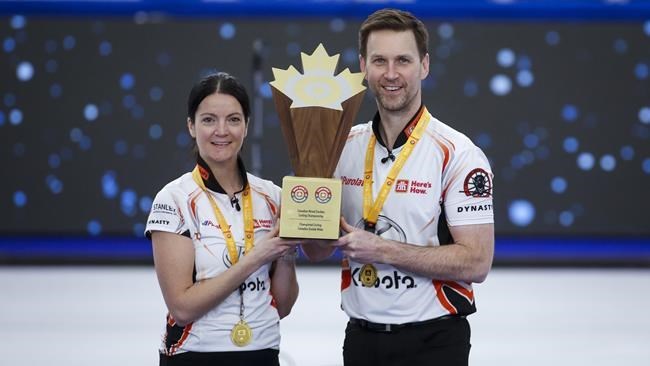CALGARY — Canada's Brad Gushue and Kerri Einarson face some non-traditional opponents in the inaugural Pan Continental championship starting Monday in Calgary.
Kazakhstan, Hong Kong and Chinese Tapei are among countries in a new World Curling Federation event designed to both streamline the world championship qualification process and provide an equivalent to the 47-year-old European championship that is a worlds qualifier.
The seven-day Pan Continental concluding Nov. 6 at Calgary's WinSport Event Centre is the 2023 world championship qualification route for all countries outside of Europe.
Einarson, winner of three straight national women's titles, opens Monday against New Zealand.
Gushue, who claimed a third career Canadian men's crown in March, starts the same day against the United States.
"It's going to be a little bit of an eye-opening experience for our team just because, with the exception of the American team, the Koreans and Japan, we're not going to know many of the other teams," Gushue told The Canadian Press.
The Pan Continental replaces the Pacific-Asia Curling Championship and the Americas Zone Challenge.
The Americas zone was guaranteed two world championship berths with Canada and the United States taking them by default most years.
Brazil did challenge Canada for men's world championship berths in 2018 and 2022 and was defeated both times.
Mexico joined Brazil in the zonal challenger for 2022 and was also beaten by Brendan Bottcher.
The Pan Continental features nine countries in the women's A division and four in the B.
Sixteen men's teams are split evenly between the two divisions.
Finishing top five in the men's and women's A divisions assures those countries of playing in the 2023 world championships.
Canada as the host country already has automatic entry into next year's men's championship in Ottawa, which leaves the rest of the A division vying for four men's berths in Calgary.
When Curling Canada invited Gushue earlier this year to represent the host country in the Pan Continental, the skip initially questioned the upside for his team's participation.
"While we're playing in this, a lot of our competitors are going to be playing in some bigger cashspiels with a lot of points and the potential to win money in those cash events," Gushue pointed out.
"We're looking at this as an opportunity for us to get on arena ice in that world setting. It is different than playing the Briers. World Curling Federation handles the events much differently than Curling Canada."
E.J. Harnden new to the team at second was another consideration.
"An opportunity to play in that is beneficial, especially with E.J. coming onto the team," the skip said. "The TV exposure for our sponsors has a big benefit for us as well.
"Hopefully down the road we get a chance to go to a world championship or another Olympics. Having this will make us that more prepared for that event."
Gushue's foursome claimed silver medals in April's men's world championship in Las Vegas, while Einarson and company were the women's bronze medallists in Prince George, B.C., in March
Einarson played the 2021 women's national and world championships in a WinSport Event Centre empty of spectators because of the COVID-19 pandemic.
The skip didn't hesitate to shoulder the responsibility of securing Canada's place in next year's women's world championship in Sandviken, Sweden.
"We all know what it's like, the pressure you feel when you wear that Maple Leaf," Einarson said. "Any chance you get to do it, and that feeling you feel when you're wearing it, it gets a little lighter.
"When we were asked to represent Canada in this event, we were all over it. It's such an honour always to wear the Maple Leaf, especially in Canada where our family and friends and fans can come cheer us on.
"It's going to be weird playing in that facility with actual people."
The women's field features Satsuki Fujisawa, who skipped Japan to Olympic silver in February as well as bronze four years ago.
Australia, Brazil, Hong Kong, Kazakhstan, South Korea and the U.S. join the Canadians and the Kiwis in the women's A division.
Gushue joins Australia, Brazil, Chinese Taipei, Japan, Korea, New Zealand and the U.S. in the men's A division.
B division countries are playing for promotion. Chinese Taipei, Kenya, Mexico and Nigeria make up the women's B.
Guyana, Hong Kong, India, Kazakhstan, Kenya, Nigeria, Qatar and Saudi Arabia round out the men's B.
The pandemic's residual effects on WCF competition increased the size of the women's A division from eight to nine teams for this year only.
New Zealand's women and Australia's men replaced China, which withdrew from the A divisions.
Gushue and Einarson are favourites to take the first Pan Continental titles. Finishing top five is well within their capabilities.
Stepping on world and Olympic podiums is no longer a given for Canadian curling teams, however, as other countries have learned how to win in the sport.
It might not take Pan Continental competition long to learn those lessons, Gushue cautioned.
"I don't see too much concern in Canada finishing top five out of top eight or nine, but certainly as countries put a little more money into this sport, and if they follow a model like Sweden or Britain and focus on two teams and put a lot of money behind them, we may get in a position where Canada doesn't qualify," Gushue said.
"You look at the emergence of Korea and China and Japan and the quality of teams they're putting forward, especially on the women's side, that came on pretty quick.
"Now you throw another couple countries into that equation, Canada would have to play pretty well to make sure they qualify. I think we're OK for a few years, but down the road it could be little iffy."
This report by The Canadian Press was first published Oct. 28, 2022.
Donna Spencer, The Canadian Press



